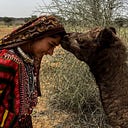Van Gujjars in National Dailies
By Pierre-Alexandre Paquet & Kaveri Choudhury
During the Covid-19 lockdowns of 2020 and 2021, it became difficult to know about communities living in the far peripheries of major towns and cities. For the Van Gujjars of Uttarakhand and Uttar Pradesh, whose livelihoods depend on the sustenance of their cattle, Covid restrictions critically hampered their capacity to thrive. The only way we knew of the Van Gujjars’ struggles during this period was through the media. While it was not possible for us to visit our contacts and friends, this challenging period presented an opportunity to investigate how the newspapers represent the Van Gujjars. What kind of information does the average news reader get about the nomadic Van Gujjars? And, are Van Gujjar voices faithfully related in daily news reports?
To answer these questions, we investigated the publications of four major Indian dailies, two in English (The Times of India and the Hindustan Times) and two in Hindi (Amar Ujala and Dainik Jagran). Using the Google search engine, we ran queries using a range of alternative spellings (Van Gujjars, Gujar, Gurjars, etc.). For the year 2021, we gathered a total of 45 newspaper articles mentioning the Van Gujjars. Then we turned our attention to how the journalists represented the Van Gujjars.
Perusing the 45 articles, we found that a wide range of events related to the Van Gujjars had gotten some coverage in mainstream media. There were reports of Human-animal conflicts (8 articles), Natural and man-made disasters (4 articles), Interventions by local MLAs and NGOs (12 articles), Civic Rights (2 articles), State denial of pastoralist rights (7 articles), Eviction and rehabilitation (10 articles), Clash with the Forest Department (3 articles), Protests (2 articles) and Other miscellaneous events (2 articles). However, a key finding remains that although these articles all relate to Van Gujjar’s issues, they rarely relay their point of view.
We also identified whom the journalists made mention of (state workers, NGOs, citizens, etc.) and whether these actors were mentioned because they did something (actively) or because something had happened to them (denoting passiveness).

Without a surprise, the Van Gujjars got the most mentions. After all, the community was the focus of our probe. What surprised us more, in the end, was that the Van Gujjars were seen as being “active” only 36.11% of the time. This suggests that the media are more inclined towards reporting on events where the Van Gujjars come across as victims, instead of as actors of change. In comparison, state actors were assumed to be taking matters actively on their ends 70-to-100% of the time. This kind of reporting, we argue, reifies the image of a powerful state and disorganised communities. Years of field studies tell us the opposite is closer to the truth.
This situation is upsetting. In different countries, the news media have adopted ethical guidelines that guarantee fair and equal representation to those whose story is being told. For the Van Gujjars these days, better representation could entail a more systematic inclusion of their voices and a more thoughtful consideration of the trope of victimhood. As expert dairy producers, the Van Gujjars we know are never idle, always active. They are very knowledgeable too, and they could write volumes about the injustices they have faced over time. They never remain passive in the face of adversity. And they should be listened to, more attentively, and receive a less complacent portrayal in the news, lest we tolerate a new injustice.
Pierre-Alexandre Paquet (paquetpierrealexandre@gmail.com) is a Postdoctoral fellow at the Nelson Institute for Environmental Studies, University of Wisconsin-Madison.
Kaveri Choudhury is an Environmental research Professional Based in Delhi.
